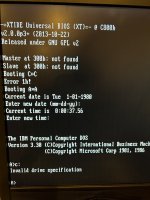chris2fett
Member
- Joined
- Mar 19, 2023
- Messages
- 23
After spending some time online in these forums and YouTube, I am not surprised to have some growing pains with installation. Hoping someone here may help me trouble shoot a little, since I am still a newbie at this. I recently purchased a
Lo-tech XT-CF lite V2: having some initial install issues with my new card. Booting my Leading Edge Model D (Phoenix bios v2.13), with 640K, a VGA video card (a JAX-8216A/V1 TRIDENT TVGA9000B VGA card MXB120) and two 5.25 360K FDD installed. When turning on the computer, I get the XT-IDE BIOS info and then the following message:
Master at 300h: not found
Slave at 300h: not found
Booting C>>C
Error 1h!
Booting A>>A
This happens whether there there is a CF card in the slot or not.
I've changed the ISA slot card position, changed J1 (ROM either D800h or C800h) and J2 (IO port 320h or 300h) to see if these would correct the issue. Not sure what to do next. Any advice? I am just trying to get drive C: recognized, so I can then erase the MBR and format the CF card and make it bootable. II heard it's possible that some VGA card can use the 300h address for memory, but I'm not sure if my budget card does or not.
Thanks for your help!
Lo-tech XT-CF lite V2: having some initial install issues with my new card. Booting my Leading Edge Model D (Phoenix bios v2.13), with 640K, a VGA video card (a JAX-8216A/V1 TRIDENT TVGA9000B VGA card MXB120) and two 5.25 360K FDD installed. When turning on the computer, I get the XT-IDE BIOS info and then the following message:
Master at 300h: not found
Slave at 300h: not found
Booting C>>C
Error 1h!
Booting A>>A
This happens whether there there is a CF card in the slot or not.
I've changed the ISA slot card position, changed J1 (ROM either D800h or C800h) and J2 (IO port 320h or 300h) to see if these would correct the issue. Not sure what to do next. Any advice? I am just trying to get drive C: recognized, so I can then erase the MBR and format the CF card and make it bootable. II heard it's possible that some VGA card can use the 300h address for memory, but I'm not sure if my budget card does or not.
Thanks for your help!
Last edited:

